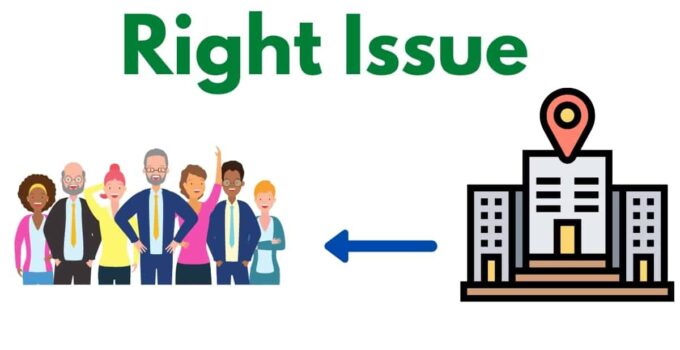At present, interest rates on bank deposits are very low. Pensioners, People who work in IT industries and middle class (who are going to retire in the last five to ten years) now have a significant grow in interest in buying and selling shares But this traders/investors mostly ignores annual reports of company. This people only looking for dividend given by company. Now, annual reports come online.
What is Right Issue?
This is true even if the stakeholder opinion is required, e.g. In case of special meeting, change of rules, increase in honorarium of directors, the company sends a letter to all the shareholders to seeking their opinion. The right issue is one of them.
When the company wants to raise capital for expansion and does not want new shareholders, the company contacts all the shareholders on the company’s for the right issue shares as per Section 62 of the Companies Act 2013 by sending letters to their last address. Currently many companies are giving their shareholders right shares.
The existing shareholder is entitled in such a case that if such company issues new shares, he can purchase them at the investment price declared by the company. The price at which the right shares are declared is clearly stated in the declaration issued. All aspects need to be examined before investing in Right issue.
Understanding How Rights Issue Works
Before introducing right issue in market company thinks some factors and they are listed below.
- How many right shares should be given to each shareholder?
- How much should it cost?
- What effect will the right issue have on the market share (before and after)?
lets assume Tata Motors is a company that produces vehicle, spindles, shafts, etc. The company has now decided to make gear box and shapers for four wheelers & heavy vehicles. The company will need additional capital to meet the technical requirements, staff (skilled, unskilled and general) etc. So before launching this new product, the company has to fulfill some essential requirements.
For Example
- The additional capital will be Rs. 100 crore.
- The price of this new right issue share is fixed at Rs. 667 / – per share.
- At present the number of shareholders is 15 lakh.
- The market value of one (1) share of the company is Rs.680 / -. (Usually the price of the right issue is kept below the market price so that the objective of paid-up capital can be achieved by getting full response from the shareholders)
This raises the following questions.
- How many (excess) shares should be sold so that the expected capital can be raised?
- How many shares of the company should the shareholder have in order to get this right issue?
- What will be the value of (one) of this right issue share?
Lets We Understand With example
- Required Capital Rs.100 Crore
- Current 15 lakh register shareholders
- Company ready to dilute new 15 lakh shares through right issue.
Now Rs 100 crore. If the capital is to be raised from 15 lakh shareholders (its price is Rs. 667 / – per share).
Now 15 lakh shares are to be distributed to 15 lakh shareholders & company motto is no one should be treated unfairly, then you can get 1 share in the new issue (right issue). In short, if you have 5 shares of the company, you will get 5 shares in the right issue. (5/5 = 1)
Now let’s calculate the value of the first 15 lakh shares + 15 lakh new shares which became a total of 30 lakh shares. At present the market price is Rs. 680 / – per share, so the price of (15 lakh x 680) + (15 lakh x 667) right issue is fixed at Rs. 667 / – per share.
- 30 lakhs (number of shares) = Rs. 673.5
- The current market share price is Rs. 680 / -.
- The current market share price is Rs.673.5/ – (in case of right issue)
- Value or Price of Right Issue Rs.7.5 / –
Shareholder Available Options in Right Issue
- Acquisition of right issue (1 right issue if 1 old shares or 10 new shares if 10 shares)
- Selling right issues
- Sitting still without doing anything
Lest Consider 1st Option
The old 10 shares plus the new 10 shares = 20 shares at a market price of Rs. 673.5 x 20= 13,470 i.e. the price according to the old price is 680 x 20 = 13600 and 13600 – 13470= 130 Rs. Will benefit. (If right issue is taken).
2nd Option
According to the second option, if the shares of right issue are sold, 7.5 * 10 = 75 + 673.5 * 10 = 6810. If shares sold at old price 10*680= 6800 than rs.10 is the profit.
3rd Option
If the third option is accepted, 673.5 * 10 = Rs. 6735 That’s the price of shares. When the share price goes down due to right issue, there will be a loss of Rs.75.
Advantages of Right Issue for Company
- As mentioned earlier, the shareholder’s ratio remains the same, so the hold on the company remains the same.
- Costs are very low. Also, selling shares below market price is very likely to replenish the capital.
- I.P.O. (Initial Public Offer) requires a number of SEBI permits and an increase in the number of shareholders can lead to a change in hold on the company.
- Balancing is difficult for I.P.O. if demand falls short or the share price falls later. E.g. Angel Broking I.PO. The market share of Angel broking was lower than the rate given in the IPO.
Take a Look




